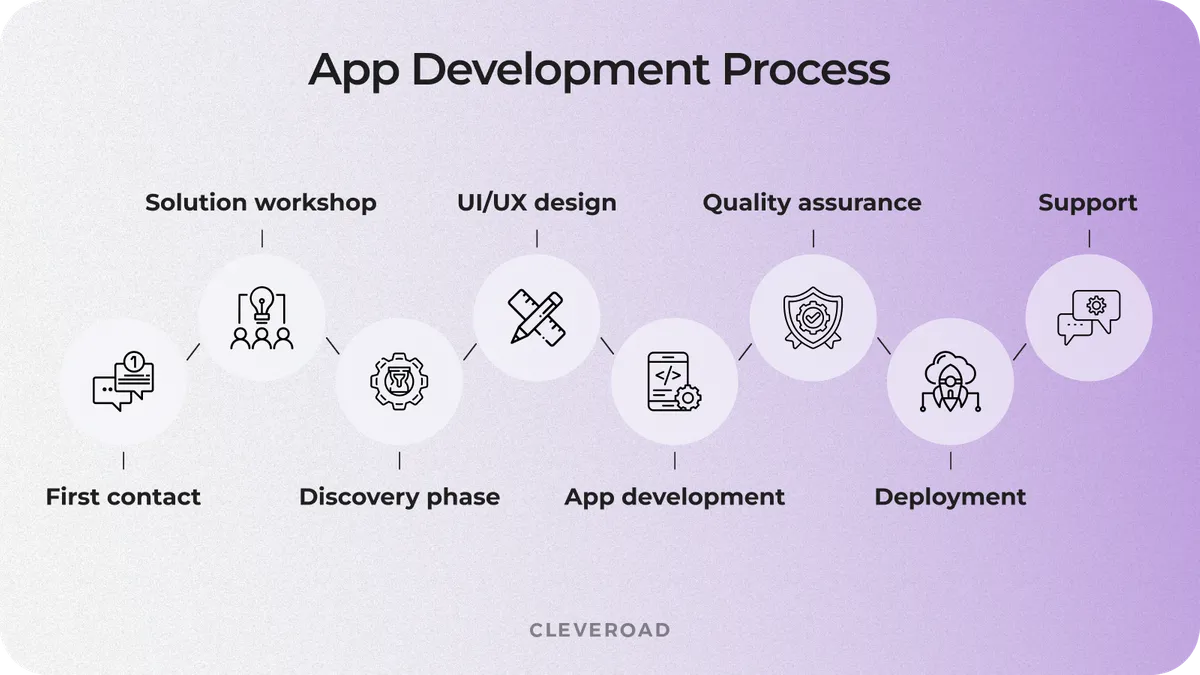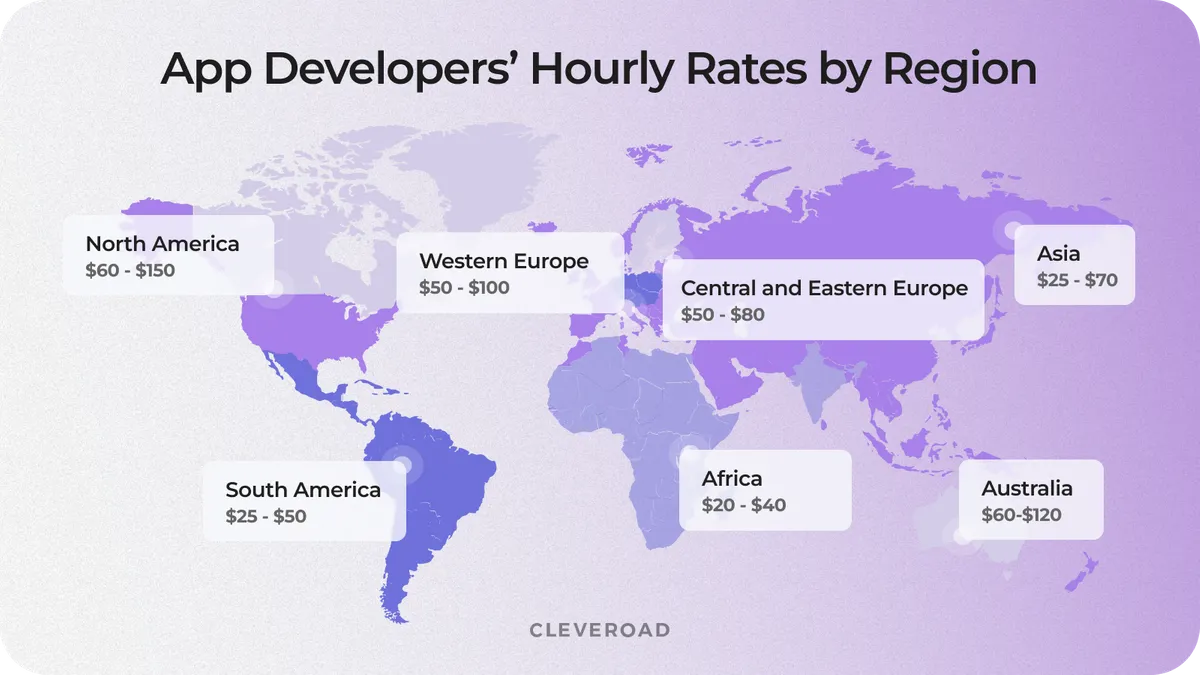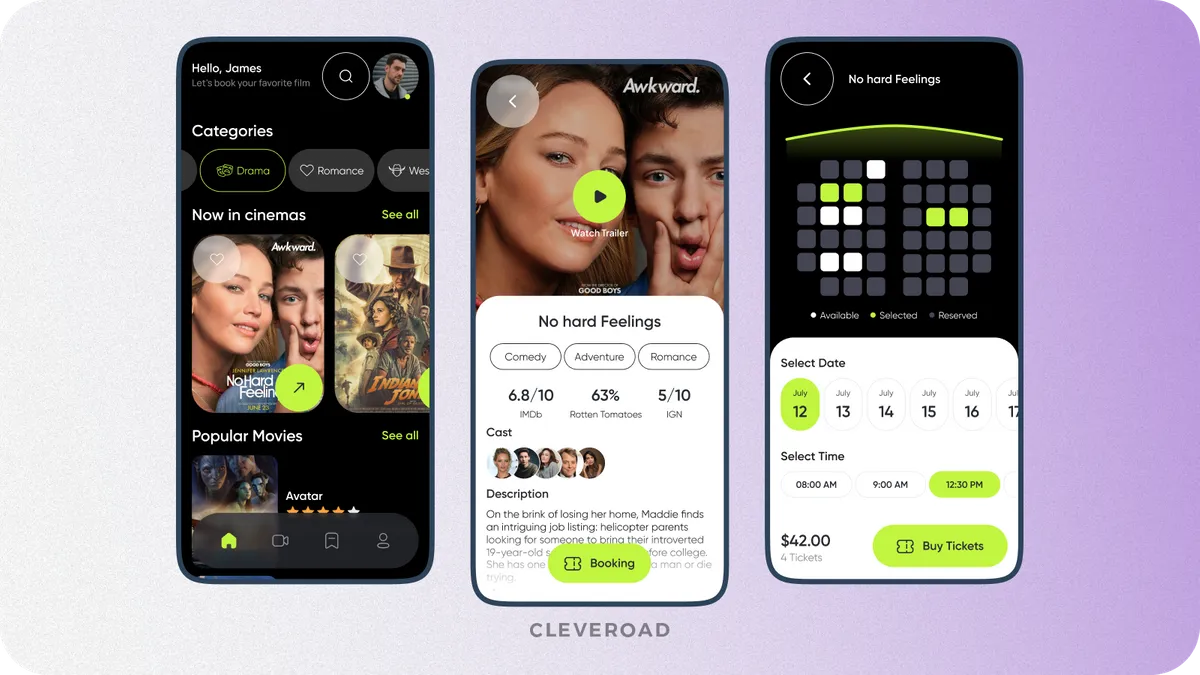Mobile App Development Process: Cleveroad's Step-by-Step Guide
Updated 08 Jul 2025
13 Min
1917 Views
App development process is a structured approach to designing, building, testing, and launching mobile applications that meet specific business objectives. To create user-friendly and technically robust products, it’s essential to follow a well-defined development flow, ensuring each stage contributes to a seamless and high-quality final outcome ready for the market.
At Cleveroad, we’ve been developing mobile applications since 2011. Such experience has helped us refine a clear, structured, and highly efficient development process. Our approach enables our clients to launch scalable, high-quality products faster without unnecessary risks or delays.
In this article, we’ll guide you through our step-by-step process of mobile app development based on Cleveroad’s Software Development Life Cycle (SDLC). You’ll learn:
- How to start app development the right way with discovery, planning, and expert input that reduces risks from day one
- How designers and developers turn your idea into a real product with a step-by-step view of the full development workflow
- How to keep quality high through testing, smooth deployment, and expert post-launch support
- How much does it cost to build an app in 2025, with real pricing ranges based on app complexity
App Development: Step-by-Step Process
What is the process of app development? The app development process is a structured workflow for building mobile or web platforms. It includes planning, designing, coding, testing, launching, and maintaining the app across its lifecycle. Understanding these steps ensures your product is delivered efficiently, meets user expectations, and aligns with your business goals.
Below is a concise breakdown of the app development step by step process, from first contact to post-release support:
- Step 1. First contact & needs analysis. Clarify product vision, sign an NDA, and discuss business goals with a Business Development Manager.
- Step 2. Solution Design Workshop. Analyze business challenges, suggest high-level architecture, define tech scope, and prepare a rough estimate.
- Step 3. Discovery Phase. Detail the feature list, define the UX concept, and create the system architecture and documentation for development.
- Step 4. UI/UX design. Build interfaces that match brand identity and meet usability standards.
- Step 5. App development. Implement app functionality in 2-week sprints, covering both backend and frontend development.
- Step 6. Quality assurance. Execute manual and automated testing to ensure the app runs smoothly and meets requirements.
- Step 7. Deployment. Publish the app to marketplaces like the Apple App Store and Google Play or other production environments.
- Step 8. Ongoing support & performance monitoring. Maintain stability, monitor app performance, fix issues, and release future updates.

App development step-by-step process
Stage 1. Preparatory Steps
The app development process steps begin with careful planning to reduce risks, define priorities, and set the foundation for efficient delivery.
Let’s examine the key steps in the preparation stage of app development.
Step 1. First contact & needs analysis
The first step is the entry point of the process for mobile app development, where you reach out to your software vendor to share your product vision. At this stage, you submit a request to the vendor with a brief description of your project idea. A representative responds, discusses your general expectations, and schedules a follow-up call with the appropriate technical team. If needed, a Non-Disclosure Agreement (NDA) is signed to ensure full confidentiality from the start.
At Cleveroad, a manager with experience in your business domain answers your request within 24 hours. They’ll briefly clarify your product vision, arrange an intro call with our solution team, and handle all paperwork, including NDA signing, ensuring the process is smooth, confidential, and ready for the next step.
Step 2. Solution Design Workshop
The Solution Design Workshop connects your business needs with a high-level technical strategy. At this stage of the app building process, your vendor’s domain experts work closely with you to understand the problems you aim to solve with software, clarify your expectations for the product, and define its functional scope. They suggest feasible tech solutions and outline the system’s architecture. In parallel, they evaluate any constraints, such as specific timelines and budgets, to ensure the proposed solution fits your business realities.
Cleveroad’s Solution Team includes a Business Analyst with solid knowledge in your specific business domain, an AWS-certified Solution Architect, and designers. The solution Design stage typically takes up to 2 weeks, depending on your app's requirements and complexity.
At the end of this step, you will receive a set of strategic deliverables, such as a value stream diagram, a high-level feature list, an architecture Diagram, a Software Architecture Document (SAD), and a team composition with a proposed tech stack. After a Solution Design Workshop, we also provide a rough app building process time and cost estimation by sprints based on your initial requirements and our previous experience with similar products.
Note: At Cleveroad, we provide a Solution Design Workshop for free. Book a call with our Solution team now to discuss your application.
Step 3. Discovery Phase
The Discovery Phase turns a product concept into a validated execution plan. At this stage, you and your IT partner align on all functional and non-functional specifications, including business logic, performance, usability, security, and scalability. The vendor helps you choose the right platform depending on your goals. It can be iOS or Android or may suggest cross-platform app development services to launch faster and cut development costs by up to 50%.
Together, you’ll define the app’s features, third-party integrations (e.g., Stripe, Google Maps), and a high-level design concept. With this information, your IT partner’s team prepares documentation and cost estimates accurately enough for contract signing and sprint planning.
Cleveroad's Discovery Phase involves a cross-functional team: Business Analysts, Solution Architects, Designers, and Developers. The Discovery Phase deliverables include:
- Feature Breakdown List (FBL)
- UX map and design concept
- Software Architecture Document (SAD)
- Quality attributes analysis
- Business process diagrams
- Rough development estimate
- Techstack proposal
- Competitor & domain research
Book our Product Discovery Phase service to kick-start your application-building process with our team of IT experts
Stage 2. Designing and Developing the App
Once you validate requirements and architecture with your vendor, the next stage of the mobile app development process focuses on implementing the core logic and iterating toward a functional product. Let’s consider the main steps at the development stage.
Step 4. UI/UX design
Mobile app design is the first tangible output of your app. This step of the app dev process transforms early specifications into structured user experiences. It begins with wireframes to outline screen logic, evolves into high-fidelity mockups, and ends with clickable prototypes for usability validation. Such an approach helps align the views of all stakeholders and reduces rework during the design creation.
At Cleveroad, we have experienced designers with mobile-first expertise who lead UI/UX design services. To build a mobile app design, we follow a systematic approach, which involves wireframing key user flows, building visually consistent mockups, and assembling an interactive prototype. We prioritize creating a consistent design that aligns with your brand identity and allows you to make a visually appealing and convenient application.
Step 5. App development
At this step, your app begins to take shape. The mobile application development process covers both backend and frontend work. The backend ensures data flow, business logic, and security, while the frontend delivers responsive and intuitive user interfaces.
If you aim to release early, the Minimum Viable Product (MVP) strategy lets you launch with core features and expand later. The MVP includes only the essential functionality needed for the app to fulfill its primary purpose. In contrast, a full version includes all planned functionality from the start but requires more time and budget.
MVP development allows you to reduce development time and costs by skipping complex, non-critical features in the initial version. Once released, the MVP can be tested in real market conditions, helping you gather valuable user feedback and make data-driven decisions for future iterations.
Below is a breakdown of the key differences between MVP and full-scale development:
| Development criteria | Minimum viable product | Full version development |
Purpose | Validate idea and test suitability | Deliver a complete product |
Time to market | 2–6 months | 6–12+ months |
Development cost | Lower initial investment | Higher upfront cost |
Feature scope | Only core, must-have features | All planned features |
User feedback | Collected post-launch | Collected later, often after full release |
Scalability | Easily extended based on feedback | Built with all intended features |
Best for | Startups, early-stage products | Mature businesses |
Cleveroad’s developers handle development stage following Agile SDLC, specifically the Scrum framework, to deliver value in short, iterative cycles. Development is broken into two-week sprints, during which the team builds and tests a defined portion of your app’s functionality based on prioritized requirements. We maintain full transparency throughout the process by holding sprint planning sessions, retrospectives, and reviews at regular intervals, always scheduled to accommodate your stakeholders. This allows for fast feedback, timely adjustments, and continuous alignment with your evolving business needs.
Cleveroad has in-depth experience in mobile app development. To prove our skills, we’ll demonstrate our recent case study.
We provided dedicated development team services for our customer, the Australian Rowing Association. They are the nation’s leading authority in rowing sports, playing a key role in advancing the sport at both grassroots and professional levels. They needed a hands-on technical partner to develop a mobile app and web application admin panel from scratch. And Cleveroad became such a partner.
Our team led the project through every stage, from the Discovery Phase to the MVP release and beyond. Cleveroad Solution Design Workshop helped identify feature priorities, technical constraints, and the best-fit development approach. Also, our specialists proposed a cost-efficient development strategy for an app using Flutter for a single codebase across iOS and Android.
As a result, our client received a fully functional, scalable fitness platform tailored to the specific needs of their community that empowered rowers with personalized training programs, seamless device integration, and real-time performance tracking
Here’s what Georgia Beattie, Director at the Australian Rowing Association, says about collaboration with Cleveroad:
Georgia Beattie, Director at Australian Rowing Association, on Successful Partnership with Cleveroad
Step 6. Quality assurance
Quality Assurance (QA) makes sure that your app runs smoothly, functions as intended, and meets all technical and user experience requirements. It includes app testing for functionality, usability, security, and compatibility across different devices, platforms, and usage scenarios. This app building process step helps prevent post-release failures and guarantees a stable and user-ready product (Source: IJSEA).
At Cleveroad, we include QA at every sprint from day one. Our engineers employ both manual and automated testing techniques and utilize tools such as Postman, Selenium, and JMeter. Our QA process includes regression checks, performance validation, and various mobile device testing. It results in cleaner releases and reduced technical bugs, as proven by our track record of delivering apps.
Stage 3. Launch and Post-Release Support
With the app fully developed and tested, the final stage of the app dev process covers deployment and long-term maintenance. Let’s look at the main steps of mobile launch and the post-release stage.
Step 7. Deployment
Deployment means moving an app into a live environment. This includes publishing mobile apps to the App Store or Google Play. The process typically involves final configuration, store compliance checks, metadata preparation, and optional beta testing through platforms like TestFlight or internal distribution (Source: IEEE).
Cleveroad handles all technical and procedural aspects of deployment. Before release, our QA team conducts testing to ensure system stability. If they detect issues, they apply hotfixes immediately. Also, we assist with store submissions, making sure the app meets Apple and Google policies and includes all required assets.
Step 8. Ongoing support & performance monitoring
After launch, you can contact the vendor for annual updates to keep the app compatible with new OS versions and competitive and add new features based on user feedback. This mobile app development process step involves bug fixing, platform or OS compatibility updates, performance tuning, new feature rollouts, and data-driven improvements based on real user behavior.
We at Cleveroad can continue supporting your product after release by implementing enhancements, adding new features, and applying improvements based on real user feedback. Ongoing maintenance typically includes bug fixes, performance and stability upgrades, code optimization, and other adjustments to keep your app reliable, secure, and aligned with evolving business needs.
We have long-term partnerships with many clients. For example, for our customer from Saudi Arabia, for whom we developed a SAMA-compliant micro-investment platform, we continue to provide maintenance services. Our long-term partnership guarantees increased demand for the app, profit for the management company, and return on equity.
Opt for our mobile app development services to build a bespoke application and get full-cycle development support
How Much Does it Cost to Make a Mobile App?
The cost of mobile development depends primarily on the cooperation model you choose for building your product. There are three most common cooperation models:
- In-house. This model suits established companies. While it offers full control, it’s costly due to expenses like office space, equipment, and taxes. It works best when the app is already profitable, and investors are on board.
- Full outsourcing: Outsourcing or a dedicated team is a model where you hand over the app building process to an external self-managed team, which works exclusively on your product. A dedicated development team service is a suitable choice for large-scale and complex projects.
- IT staff augmentation: This outsourcing model allows you to quickly onboard external specialists with the tech expertise and domain knowledge you need on a temporary basis. IT staff augmentation service is the best choice if you need to hire a few external specialists but still keep full control over their work.
If you opt for outsourcing, you should consider how development rates vary across regions. In the US and other high-cost regions, rates tend to be higher due to the local cost of living and business expenses. In contrast, the Central and Eastern Europe region offers a perfect balance between software quality and affordability. This region combines strong engineering expertise, reliable delivery, and favorable pricing, which makes it a popular choice among startups that are looking for cost-efficient development without compromising on standards.

App developer's hourly rates depending on the region
We’ve asked our Solution Architect to estimate the approximate costs of the whole mobile development process based on an hourly rate of $50 to $80, which is typical for Cleveroad’s headquarters region –Central and Eastern Europe.
- Simple app (3-6 months of development) - $70,000-$100,000
- Medium app (6-10 months of development) - $120,000-$170,000
- Complex app (10+ months of development) - $200,000-$250,000+
Note: To learn more details about the cost to develop an app, feel free to read our comprehensive article with detailed estimations.
Why Choose Cleveroad to Handle Your App Development Process?
Cleveroad is a professional technical vendor headquartered in Estonia. We have R&D centers in Estonia, Poland, Ukraine, the US, and Norway. Since 2011, we’ve been helping startups, small-to-medium businesses, and enterprises in various industries create custom mobile applications according to their unique business goals.
Cleveroad in numbers:
- 13+ years on the market
- 250+ in-house engineers
- 200+ successful projects
- 8+ expertise industries
The Cleveroad team builds native apps for iOS and Android operating systems using platform-specific programming languages like Swift, Objective-C, Java, and Kotlin. Also, we offer cross-platform app development services (Flutter and React Native) to speed up the development. We also provide support for your legacy apps, subsequently improving them based on your needs and goals.
Cleveroad has a big portfolio of mobile app projects. We would like to tell you about some of them:
- Move Up. Transportation app that connects drivers with riders throughout the area for our client from the USA in the Transportation industry.
- El Tab. Cross-platform solution with daily propositions of free drinks based on user location for our customer from the UK in the Marketplace domain.
- AYOO. Social network designed to connect dancers from all over the globe and let them communicate interactively with our client from Switzerland.
- Photo Fi. iOS-based social media app designed to connect people for our customer from the USA.
- Just Play. A mobile solution that aligns people who engage in sports for our client from Australia.
Our clients highly appreciate the quality of services we provide. Here is what our client, CEO and co-founder of JustPlay, says about our collaboration:


Create an app with a reliable vendor
Contact us! Our experienced app development team is ready to help turn your idea into a successful application offering an exceptional user experience and competitive advantages
The app development step-by-step process is a structured workflow for building mobile or web platforms. It includes planning, designing, coding, testing, launching, and maintaining the app across its lifecycle.
Below is a common breakdown of the app development step-by-step process, whether it is a web app, an iOS app, or an Android app, from first contact to post-release support:
- Step 1. First contact & needs analysis
- Step 2. Solution Design Workshop
- Step 3. Discovery Phase
- Step 4. UI/UX design
- Step 5. App development
- Step 6. Quality assurance
- Step 7. Deployment
- Step 8. Ongoing support & performance monitoring
To build an app, start with research and a clear app development strategy. Define your type of app, choose suitable development platforms, and follow a structured development lifecycle from design to deployment.
To create a mobile app, start by choosing among different types of mobile apps: native, hybrid, or cross-platform. The design and development process begins with UI/UX creation, followed by coding the app for the selected operating system. Your mobile developer handles the implementation, while QA engineers test the product to ensure stability and performance before release.
Development models like Agile or Waterfall guide how you work with an app builder or app developer. For Android and iOS, the model helps plan, test, and release the app efficiently. Common models include:
- Agile – flexible, sprint-based approach for fast delivery
- Waterfall – linear, structured process for fixed requirements
- Iterative – gradual refinement through repeated cycles

Evgeniy Altynpara is a CTO and member of the Forbes Councils’ community of tech professionals. He is an expert in software development and technological entrepreneurship and has 10+years of experience in digital transformation consulting in Healthcare, FinTech, Supply Chain and Logistics
Give us your impressions about this article
Give us your impressions about this article
